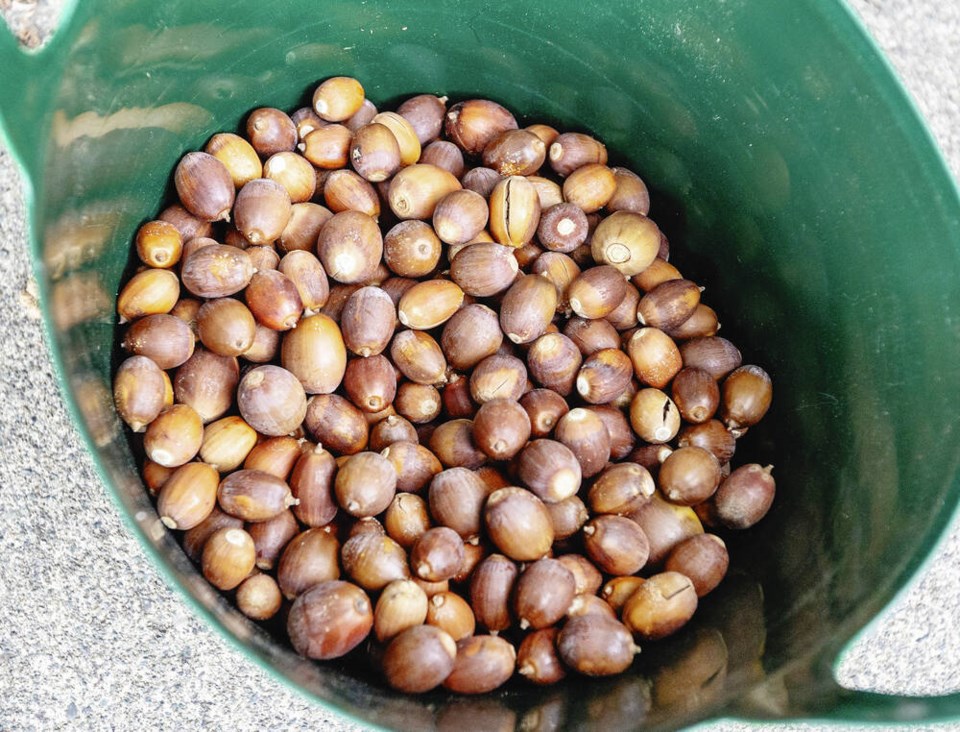“It’s too bad acorns aren’t edible,” Nature Boy said, after raking up another seven kilograms of the nuts, the fourth such harvest from our backyard this past month. “They could really help lower our food bills.”
These last two years, it has felt as if we might need to remortgage the house to buy groceries.
Since 2021, food prices have increased anywhere from 15 to more than 30 per cent, depending on what you’re buying.
Nature Boy commented recently that he feels like what he’s paying for a single Brussels sprout/cherry tomato/fingerling potato costs what an entire green cabbage/beefsteak tomato/full-size russet potato cost pre-pandemic.
“I’m not sure if that’s inflation and shrinkflation in action,” he said.
I said: “You’re exaggerating, but I see your point.”
With costs going up, effortless backyard food staples like a bountiful supply of backyard nuts would be welcome.
And I had to remind Nature Boy that, with some effort and processing, acorns actually are edible.
Acorn mush, or wiiwish or shawii, was a dietary staple for some California Indigenous peoples.
Records show the ancient Greeks, Iberians, Japanese and English ate acorns, particularly during times of famine when grains were unavailable.
During the First and Second World Wars, acorns from abundant native oak trees, as well as chestnuts and pine nuts, kept many Europeans from starving. They processed and roasted the acorns to use in bread, porridge and other daily foods. Some even used them to make ersatz coffee.
Even today, Korean and some American Indigenous cuisines feature acorns as key ingredients.
The key, then and now, to preparing acorns for food is the leaching process. Basically, acorns’ considerable tannins need to be washed away before the nuts are palatable.
Tannins are bitter-tasting, water-soluble compounds that can be toxic or cause irritation and just don’t taste good in anything other than small doses.
Small amounts add slightly astringent, palate-cleansing qualities to real tea, chocolate and wine — or “structure, balance and texture” if you want to use high-falutin’ wine-industry terms.
They also cause the unpleasant mouth-drying pucker of, for example, unripe apples, plums and pears.
They’re one of the ways plants keep their fruits out of the mouths of hungry critters until their seeds have fully matured, are capable of withstanding an animal’s gut juices, and are ready to sprout into new plants in a handy pile of post-digestion fertilizer.
There is some evidence that, at the correct small doses, tannins can accelerate blood clotting, reduce blood pressure, decrease serum lipid levels, modulate inflammation and other immune responses, and provide other health benefits.
High quantities, however, such as those found in acorns, can cause stomach irritation, nausea, vomiting and liver damage in humans.
Squirrels, mice, pigs, birds and some other animals are immune to those effects and seek out the protein- and fat-rich nuts.
We humans — delicate doilies that we are — must remove most of the tannins before eating acorns.
Online videos by numerous survivalists and foraging foodies share the choice of processes that resolve acorns’ stomach-twisting qualities. University of California, Berkeley ethnographers document how the southwestern Pomo Indians did it in pre-colonial times.
Food mills, coffee grinders, turn-a-dial stovetops, and other mod cons speed the process today.
The easiest, fastest, most accessible method for the home-kitchen acorn-processor seems to involve hot-water leaching.
According to the online videos mentioned above, this involves bringing a potful of water and shelled, cracked, sorted and coarsely milled acorns to a mad boil for several minutes, draining them, adding more water, then boiling and draining again, on repeat, up to 10 or so times, or until the kernels no longer taste bitter.
At that point, the meal is ground again, then dried thoroughly. The results can be used similarly to steel-cut oats or cornmeal, or ground finely into flour.
All this is to say this fall’s acorn bounty, raining down like shrapnel on yards, sidewalks and rooftops daily, has menu potential.
Despite this, Nature Boy has made no effort to turn the backyard acorn harvest into a grocery substitute, a sign perhaps that inconvenience has its own cost.
>>> To comment on this article, write a letter to the editor: [email protected]



